engine VOLVO XC90 2007 Repair Manual
[x] Cancel search | Manufacturer: VOLVO, Model Year: 2007, Model line: XC90, Model: VOLVO XC90 2007Pages: 268, PDF Size: 8.57 MB
Page 181 of 268
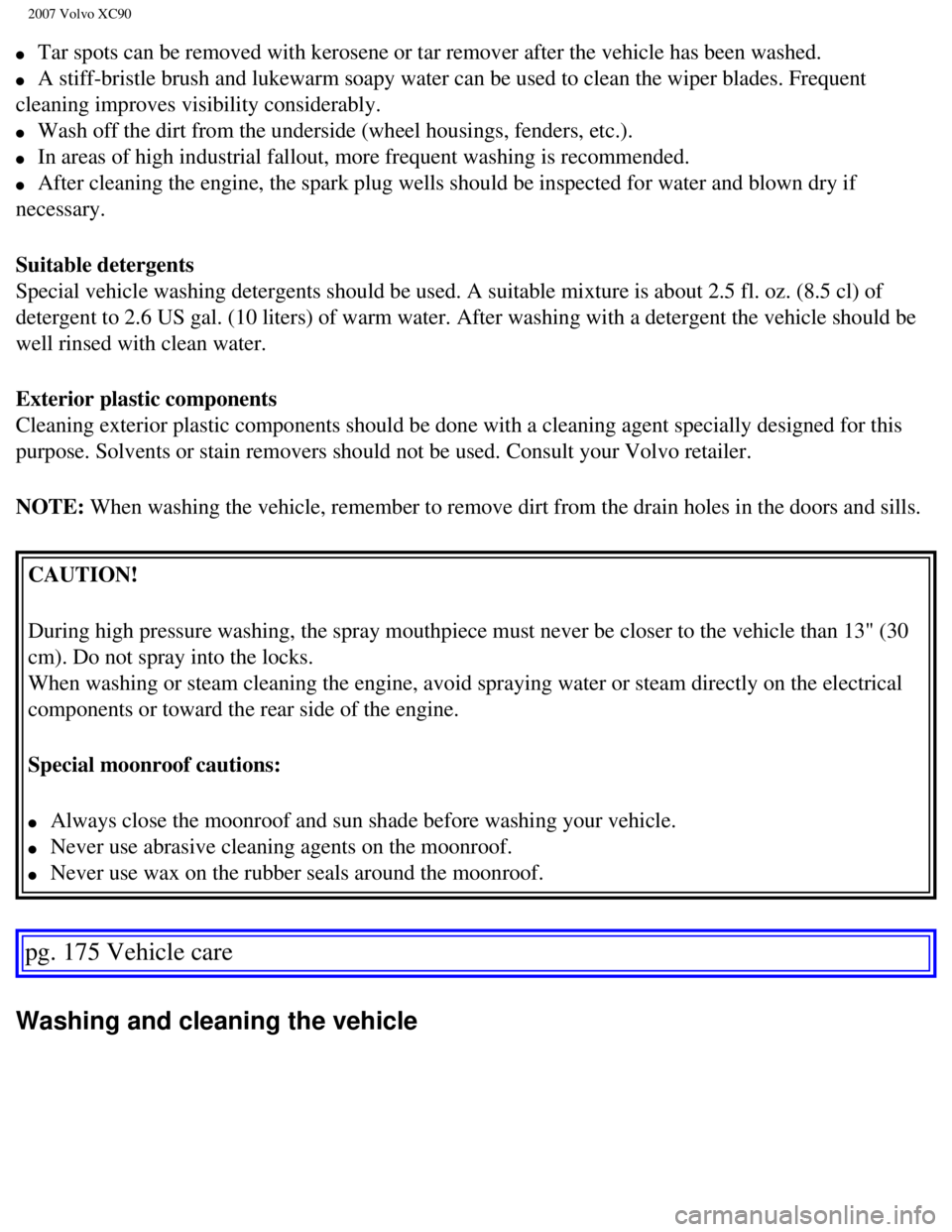
2007 Volvo XC90
l Tar spots can be removed with kerosene or tar remover after the vehicle \
has been washed.
l A stiff-bristle brush and lukewarm soapy water can be used to clean the \
wiper blades. Frequent
cleaning improves visibility considerably.
l Wash off the dirt from the underside (wheel housings, fenders, etc.). \
l In areas of high industrial fallout, more frequent washing is recommende\
d.
l After cleaning the engine, the spark plug wells should be inspected for \
water and blown dry if
necessary.
Suitable detergents
Special vehicle washing detergents should be used. A suitable mixture is\
about 2.5 fl. oz. (8.5 cl) of
detergent to 2.6 US gal. (10 liters) of warm water. After washing with\
a detergent the vehicle should be
well rinsed with clean water.
Exterior plastic components
Cleaning exterior plastic components should be done with a cleaning agen\
t specially designed for this
purpose. Solvents or stain removers should not be used. Consult your Vol\
vo retailer.
NOTE: When washing the vehicle, remember to remove dirt from the drain holes \
in the doors and sills.
CAUTION!
During high pressure washing, the spray mouthpiece must never be closer \
to the vehicle than 13" (30
cm). Do not spray into the locks.
When washing or steam cleaning the engine, avoid spraying water or steam\
directly on the electrical
components or toward the rear side of the engine.
Special moonroof cautions:
l Always close the moonroof and sun shade before washing your vehicle.
l Never use abrasive cleaning agents on the moonroof.
l Never use wax on the rubber seals around the moonroof.
pg. 175 Vehicle care
Washing and cleaning the vehicle
file:///K|/ownersdocs/2007/2007_XC90/07xc90_08.htm (2 of 7)12/30/2006 \
5:53:48 PM
Page 182 of 268
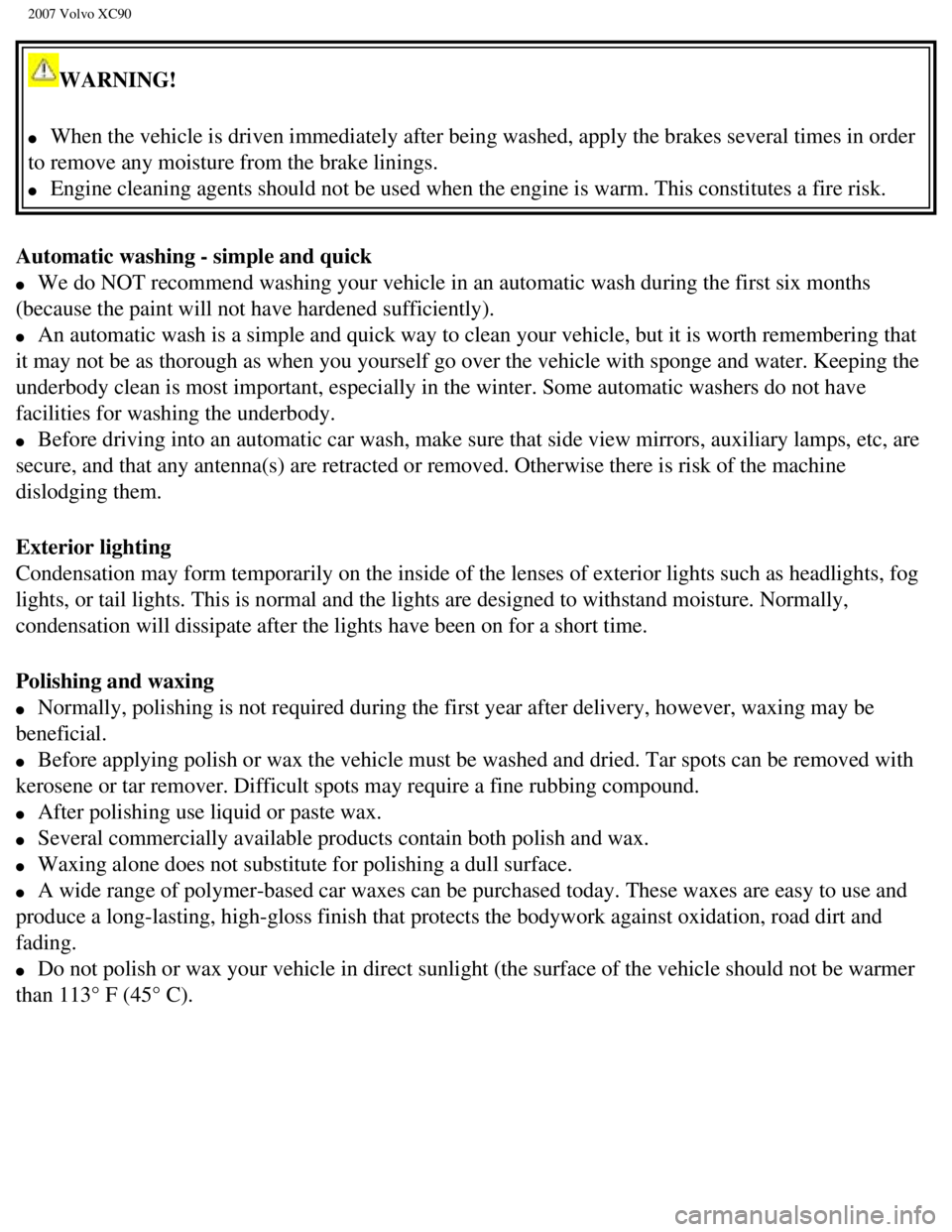
2007 Volvo XC90
WARNING!
l When the vehicle is driven immediately after being washed, apply the bra\
kes several times in order
to remove any moisture from the brake linings.
l Engine cleaning agents should not be used when the engine is warm. This \
constitutes a fire risk.
Automatic washing - simple and quick
l We do NOT recommend washing your vehicle in an automatic wash during the\
first six months
(because the paint will not have hardened sufficiently).
l An automatic wash is a simple and quick way to clean your vehicle, but i\
t is worth remembering that
it may not be as thorough as when you yourself go over the vehicle with \
sponge and water. Keeping the
underbody clean is most important, especially in the winter. Some automa\
tic washers do not have
facilities for washing the underbody.
l Before driving into an automatic car wash, make sure that side view mirr\
ors, auxiliary lamps, etc, are
secure, and that any antenna(s) are retracted or removed. Otherwise th\
ere is risk of the machine
dislodging them.
Exterior lighting
Condensation may form temporarily on the inside of the lenses of exterio\
r lights such as headlights, fog
lights, or tail lights. This is normal and the lights are designed to wi\
thstand moisture. Normally,
condensation will dissipate after the lights have been on for a short ti\
me.
Polishing and waxing
l Normally, polishing is not required during the first year after delivery\
, however, waxing may be
beneficial.
l Before applying polish or wax the vehicle must be washed and dried. Tar \
spots can be removed with
kerosene or tar remover. Difficult spots may require a fine rubbing comp\
ound.
l After polishing use liquid or paste wax.
l Several commercially available products contain both polish and wax.
l Waxing alone does not substitute for polishing a dull surface.
l A wide range of polymer-based car waxes can be purchased today. These wa\
xes are easy to use and
produce a long-lasting, high-gloss finish that protects the bodywork aga\
inst oxidation, road dirt and
fading.
l Do not polish or wax your vehicle in direct sunlight (the surface of th\
e vehicle should not be warmer
than 113° F (45° C).
file:///K|/ownersdocs/2007/2007_XC90/07xc90_08.htm (3 of 7)12/30/2006 \
5:53:48 PM
Page 185 of 268
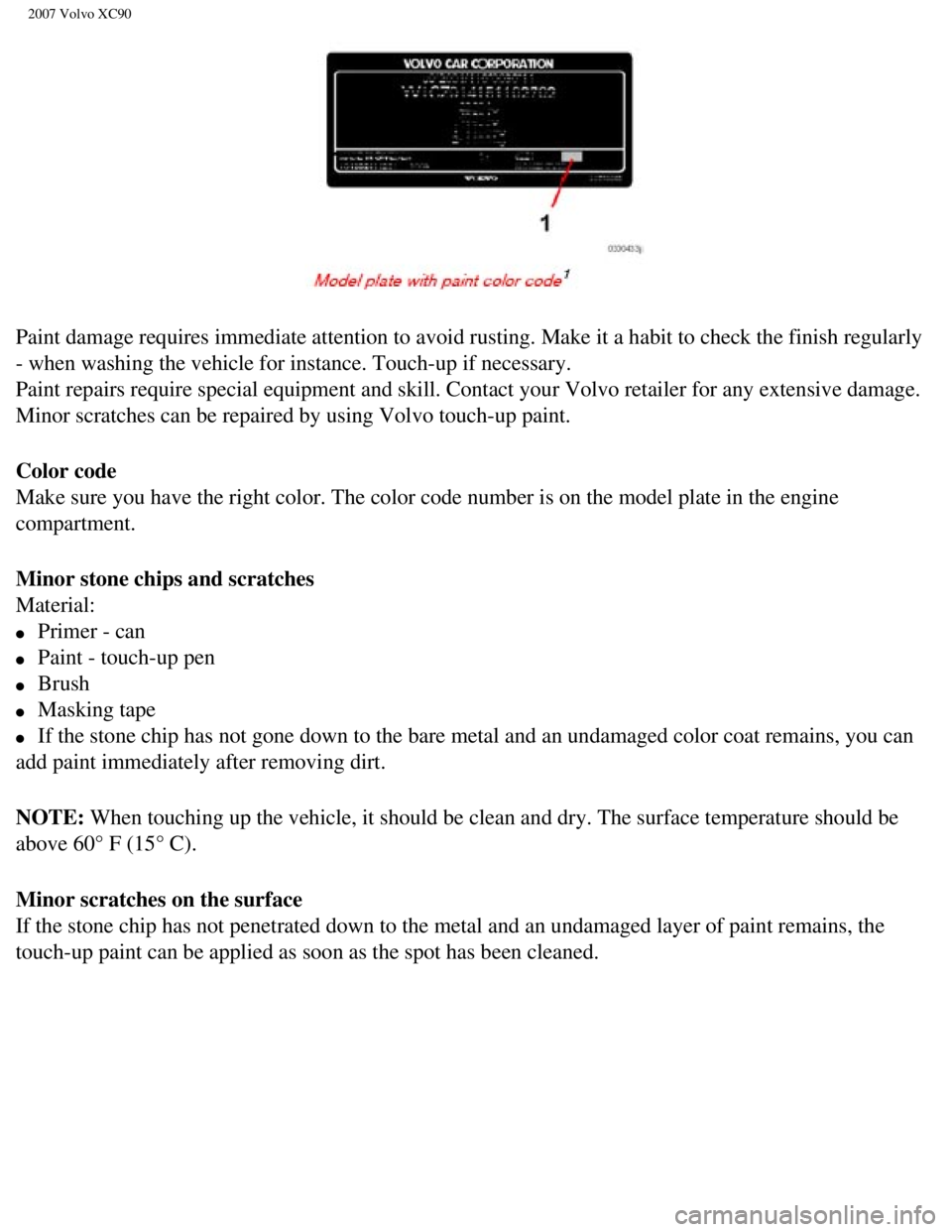
2007 Volvo XC90
Paint damage requires immediate attention to avoid rusting. Make it a ha\
bit to check the finish regularly
- when washing the vehicle for instance. Touch-up if necessary.
Paint repairs require special equipment and skill. Contact your Volvo re\
tailer for any extensive damage.
Minor scratches can be repaired by using Volvo touch-up paint.
Color code
Make sure you have the right color. The color code number is on the mode\
l plate in the engine
compartment.
Minor stone chips and scratches
Material:
l Primer - can
l Paint - touch-up pen
l Brush
l Masking tape
l If the stone chip has not gone down to the bare metal and an undamaged c\
olor coat remains, you can
add paint immediately after removing dirt.
NOTE: When touching up the vehicle, it should be clean and dry. The surface t\
emperature should be
above 60° F (15° C).
Minor scratches on the surface
If the stone chip has not penetrated down to the metal and an undamaged \
layer of paint remains, the
touch-up paint can be applied as soon as the spot has been cleaned.
file:///K|/ownersdocs/2007/2007_XC90/07xc90_08.htm (6 of 7)12/30/2006 \
5:53:48 PM
Page 187 of 268

2007 Volvo XC90
2 0 0 7
VOLVO XC90
Maintenance
pg. 179 Maintenance
Volvo service
180
Maintaining your car
181
Emission inspection
readiness
182
Working on your vehicle
183
Engine compartment
185
Engine oil
186
Fluids
188
Wiper blades
190
Battery
191
Replacing bulbs
194
Fuses
201
pg. 180 Maintenance
Volvo service
Maintenance service
Periodic maintenance will help keep your vehicle running well. Your Warr\
anty and Service Records
Information booklet provides a comprehensive maintenance schedule up to \
150,000 miles (240,000 km)
of vehicle service. This maintenance program contains inspections and se\
rvices necessary for the proper
function of your vehicle, and includes components that affect vehicle em\
issions. The maintenance
services contain several checks that require special instruments and too\
ls and therefore must be
performed by a qualified technician. Volvo advises you to follow the ser\
vice program outlined in this
booklet. To keep your Volvo in top condition, specify time-tested and pr\
oven Genuine Volvo Parts and
file:///K|/ownersdocs/2007/2007_XC90/07xc90_09.htm (1 of 37)12/30/2006\
5:53:50 PM
Page 189 of 268

2007 Volvo XC90
pg. 181 Maintenance
Maintaining your car
Owner maintenance
Periodic maintenance requirements and intervals are described in your ve\
hicle's Warranty and Service
Records Information booklet.
The following points can be carried out between the normally scheduled m\
aintenance services.
Each time the vehicle is refueled:
l Check the engine oil level
l Clean the windshield, windshield wipers, headlights, and tail lights
Monthly:
l Check cold tire pressure in all tires. Inspect the tires for wear.
l Check that engine coolant and other fluid levels are between the indicat\
ed "min" and "max" markings.
l Clean interior glass surfaces with a glass cleaner and soft paper towels\
.
l Wipe driver information displays with a soft cloth.
l Visually inspect battery terminals for corrosion. Corrosion may indicate\
a loose terminal connector, or
a battery near the end of its useful service life. Consult your Volvo re\
tailer for additional information.
As needed:
l Wash the vehicle, including the undercarriage, to reduce wear that can b\
e caused by a buildup of dirt,
and corrosion that can be caused by salt residues.
l Clean leaves and twigs from air intake vents at the base of the windshie\
ld, and from other places
where they may collect.
NOTE: Complete service information for qualified technicians is available onl\
ine for purchase or
subscription at
www.volvotechinfo.com.
pg. 182 Maintenance
Emission inspection readiness
What is an Onboard Diagnostic System (OBD II)?
OBD II is part of your vehicle's computerized engine management system. \
It stores diagnostic
information about your vehicle's emission controls. It can light the Che\
ck Engine light (MIL) if it detects
an emission control "fault." A "fault" is a component or system that is \
not performing within an expected
range. A fault may be permanent or temporary. OBD II will store a messag\
e about any fault.
file:///K|/ownersdocs/2007/2007_XC90/07xc90_09.htm (3 of 37)12/30/2006\
5:53:50 PM
Page 190 of 268
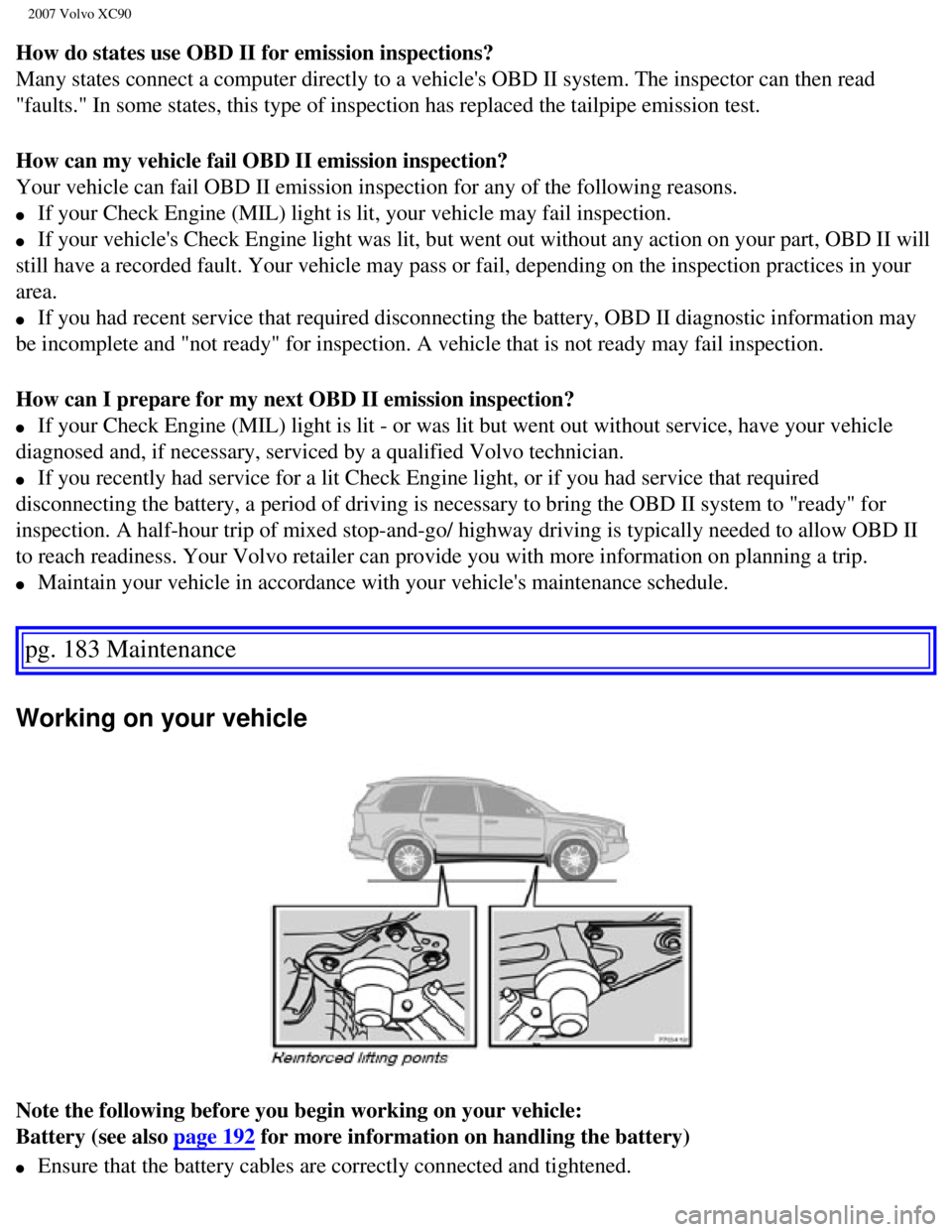
2007 Volvo XC90
How do states use OBD II for emission inspections?
Many states connect a computer directly to a vehicle's OBD II system. Th\
e inspector can then read
"faults." In some states, this type of inspection has replaced the tailp\
ipe emission test.
How can my vehicle fail OBD II emission inspection?
Your vehicle can fail OBD II emission inspection for any of the followin\
g reasons.
l If your Check Engine (MIL) light is lit, your vehicle may fail inspect\
ion.
l If your vehicle's Check Engine light was lit, but went out without any a\
ction on your part, OBD II will
still have a recorded fault. Your vehicle may pass or fail, depending on\
the inspection practices in your
area.
l If you had recent service that required disconnecting the battery, OBD I\
I diagnostic information may
be incomplete and "not ready" for inspection. A vehicle that is not read\
y may fail inspection.
How can I prepare for my next OBD II emission inspection?
l If your Check Engine (MIL) light is lit - or was lit but went out with\
out service, have your vehicle
diagnosed and, if necessary, serviced by a qualified Volvo technician.
l If you recently had service for a lit Check Engine light, or if you had \
service that required
disconnecting the battery, a period of driving is necessary to bring the\
OBD II system to "ready" for
inspection. A half-hour trip of mixed stop-and-go/ highway driving is ty\
pically needed to allow OBD II
to reach readiness. Your Volvo retailer can provide you with more inform\
ation on planning a trip.
l Maintain your vehicle in accordance with your vehicle's maintenance sche\
dule.
pg. 183 Maintenance
Working on your vehicle
Note the following before you begin working on your vehicle:
Battery (see also
page 192 for more information on handling the battery)
l Ensure that the battery cables are correctly connected and tightened.
file:///K|/ownersdocs/2007/2007_XC90/07xc90_09.htm (4 of 37)12/30/2006\
5:53:50 PM
Page 191 of 268
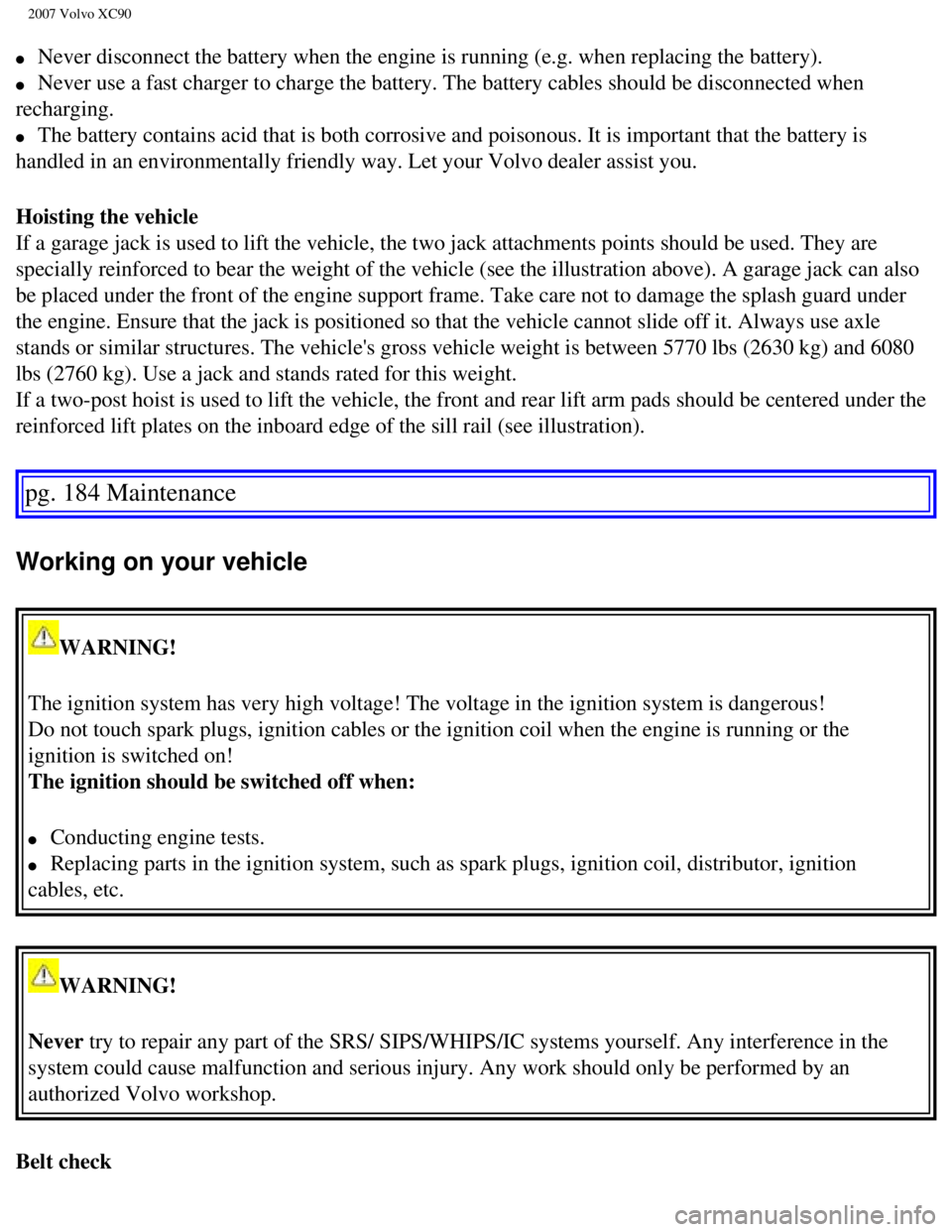
2007 Volvo XC90
l Never disconnect the battery when the engine is running (e.g. when repl\
acing the battery).
l Never use a fast charger to charge the battery. The battery cables shoul\
d be disconnected when
recharging.
l The battery contains acid that is both corrosive and poisonous. It is im\
portant that the battery is
handled in an environmentally friendly way. Let your Volvo dealer assist\
you.
Hoisting the vehicle
If a garage jack is used to lift the vehicle, the two jack attachments p\
oints should be used. They are
specially reinforced to bear the weight of the vehicle (see the illustr\
ation above). A garage jack can also
be placed under the front of the engine support frame. Take care not to \
damage the splash guard under
the engine. Ensure that the jack is positioned so that the vehicle canno\
t slide off it. Always use axle
stands or similar structures. The vehicle's gross vehicle weight is betw\
een 5770 lbs (2630 kg) and 6080
lbs (2760 kg). Use a jack and stands rated for this weight.
If a two-post hoist is used to lift the vehicle, the front and rear lift\
arm pads should be centered under the
reinforced lift plates on the inboard edge of the sill rail (see illust\
ration).
pg. 184 Maintenance
Working on your vehicle
WARNING!
The ignition system has very high voltage! The voltage in the ignition s\
ystem is dangerous!
Do not touch spark plugs, ignition cables or the ignition coil when the \
engine is running or the
ignition is switched on!
The ignition should be switched off when:
l Conducting engine tests.
l Replacing parts in the ignition system, such as spark plugs, ignition co\
il, distributor, ignition
cables, etc.
WARNING!
Never try to repair any part of the SRS/ SIPS/WHIPS/IC systems yourself. Any \
interference in the
system could cause malfunction and serious injury. Any work should only \
be performed by an
authorized Volvo workshop.
Belt check
file:///K|/ownersdocs/2007/2007_XC90/07xc90_09.htm (5 of 37)12/30/2006\
5:53:50 PM
Page 192 of 268
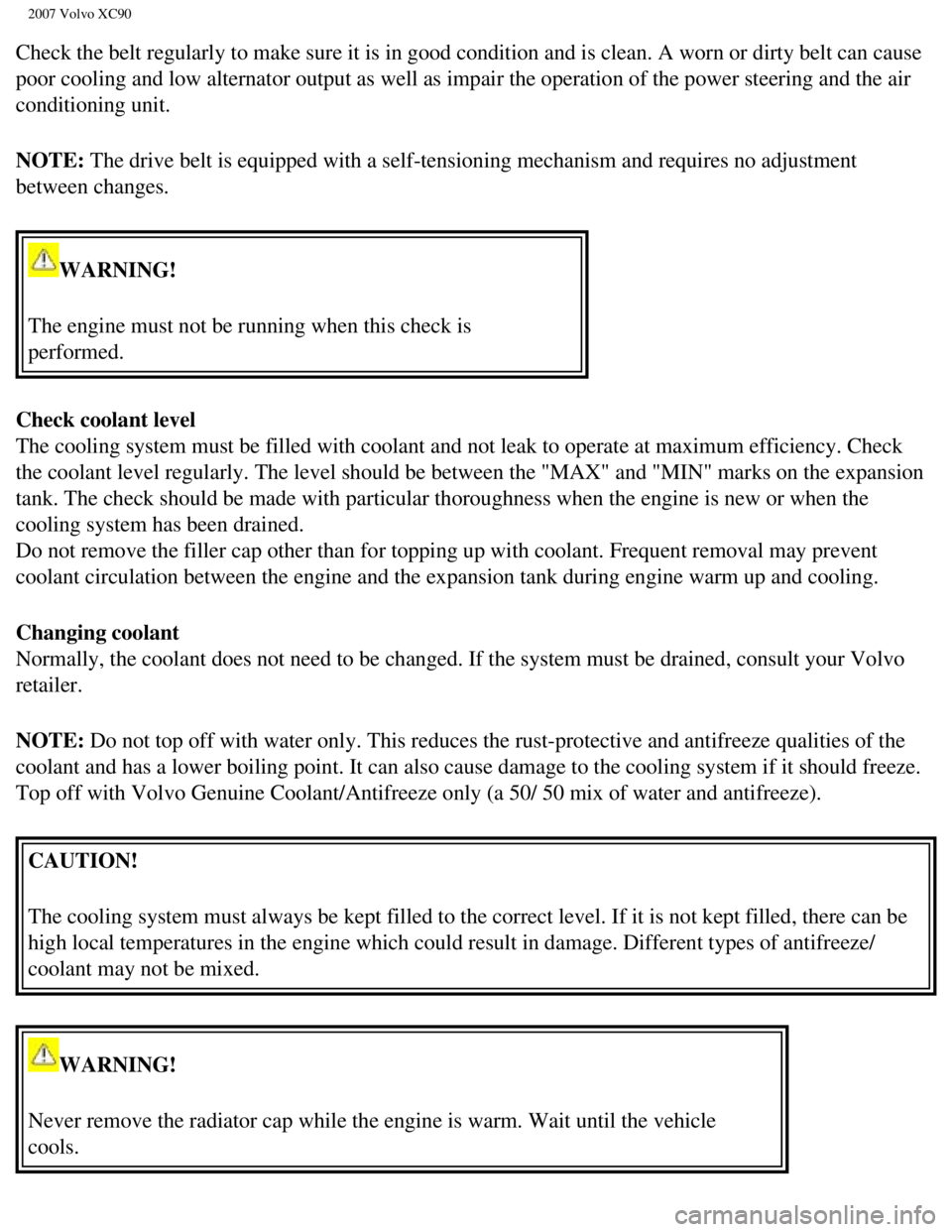
2007 Volvo XC90
Check the belt regularly to make sure it is in good condition and is cle\
an. A worn or dirty belt can cause
poor cooling and low alternator output as well as impair the operation o\
f the power steering and the air
conditioning unit.
NOTE: The drive belt is equipped with a self-tensioning mechanism and require\
s no adjustment
between changes.
WARNING!
The engine must not be running when this check is
performed.
Check coolant level
The cooling system must be filled with coolant and not leak to operate a\
t maximum efficiency. Check
the coolant level regularly. The level should be between the "MAX" and "\
MIN" marks on the expansion
tank. The check should be made with particular thoroughness when the eng\
ine is new or when the
cooling system has been drained.
Do not remove the filler cap other than for topping up with coolant. Fre\
quent removal may prevent
coolant circulation between the engine and the expansion tank during eng\
ine warm up and cooling.
Changing coolant
Normally, the coolant does not need to be changed. If the system must be\
drained, consult your Volvo
retailer.
NOTE: Do not top off with water only. This reduces the rust-protective and an\
tifreeze qualities of the
coolant and has a lower boiling point. It can also cause damage to the c\
ooling system if it should freeze.
Top off with Volvo Genuine Coolant/Antifreeze only (a 50/ 50 mix of wat\
er and antifreeze). CAUTION!
The cooling system must always be kept filled to the correct level. If i\
t is not kept filled, there can be
high local temperatures in the engine which could result in damage. Diff\
erent types of antifreeze/
coolant may not be mixed.
WARNING!
Never remove the radiator cap while the engine is warm. Wait until the v\
ehicle
cools.
file:///K|/ownersdocs/2007/2007_XC90/07xc90_09.htm (6 of 37)12/30/2006\
5:53:50 PM
Page 193 of 268
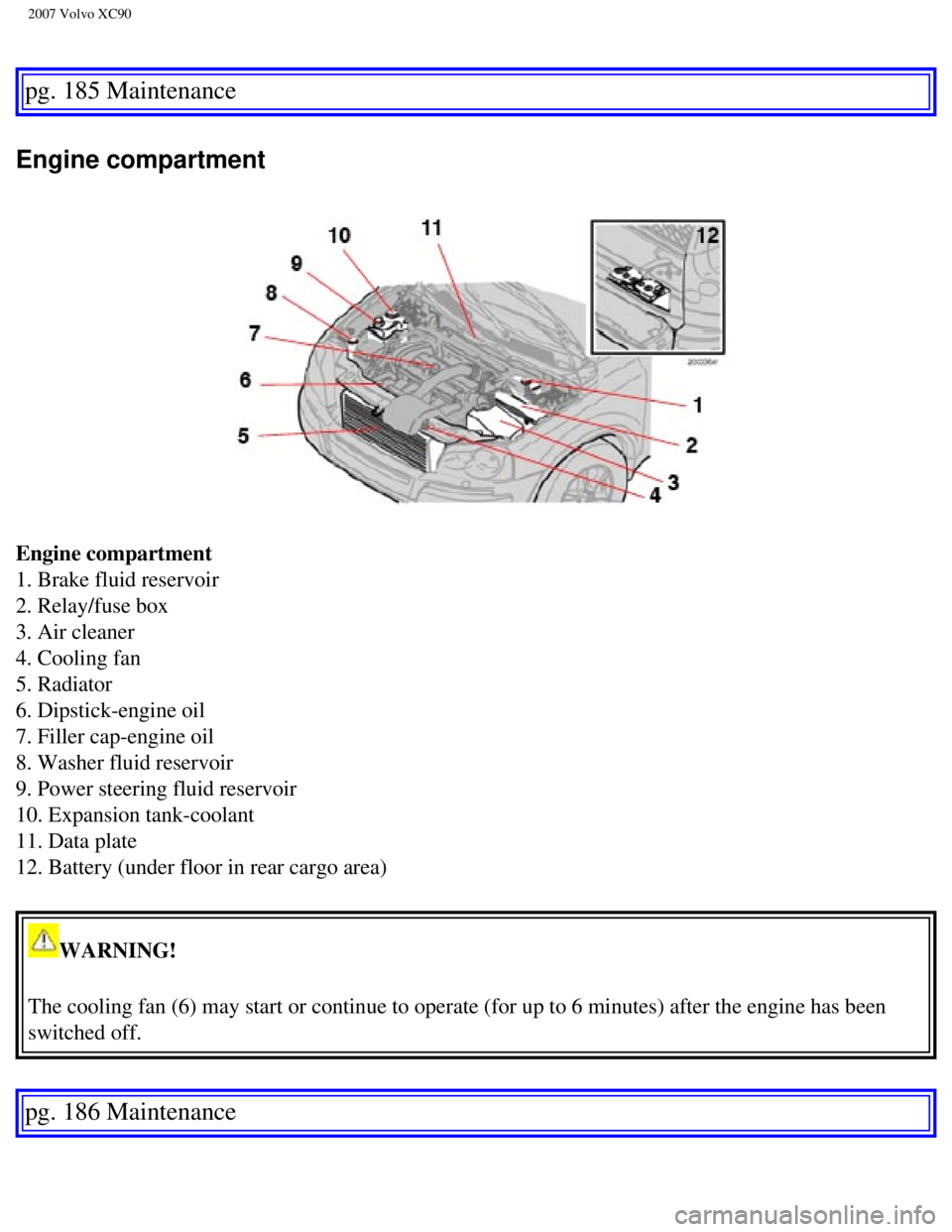
2007 Volvo XC90
pg. 185 Maintenance
Engine compartment
Engine compartment
1. Brake fluid reservoir
2. Relay/fuse box
3. Air cleaner
4. Cooling fan
5. Radiator
6. Dipstick-engine oil
7. Filler cap-engine oil
8. Washer fluid reservoir
9. Power steering fluid reservoir
10. Expansion tank-coolant
11. Data plate
12. Battery (under floor in rear cargo area)
WARNING!
The cooling fan (6) may start or continue to operate (for up to 6 min\
utes) after the engine has been
switched off.
pg. 186 Maintenance
file:///K|/ownersdocs/2007/2007_XC90/07xc90_09.htm (7 of 37)12/30/2006\
5:53:50 PM
Page 194 of 268

2007 Volvo XC90
Engine oil
Oil specifications
Engine oil must meet the minimum ILSAC specification GF-3, API SL, and A\
CEA A1/ B1. Lower
quality oils may not offer the same fuel economy, engine performance, or\
engine protection.
Volvo recommends
.
Depending on your driving habits, premium or synthetic oils may provide \
superior fuel economy and
engine protection. Consult your Volvo retailer for recommendations on pr\
emium or synthetic oils.
Oil additives must not be used.
NOTE: Synthetic oil is not used when the oil is changed at the normal mainten\
ance services. This oil is
only used at customer request, at additional charge. Please consult your\
Volvo retailer.
Oil viscosity (stable ambient temperatures)
Operation in hot climates
When temperatures exceed 86° F (30° C) in your area, Volvo recom\
mends, for the protection of your
engine, that you use a heavier weight oil, such as such as SAE 5W-40 or \
0W-40. See the viscosity chart.
Operation in temperate climates
Incorrect viscosity oil can shorten engine life. Under normal use when t\
emperatures do not exceed 86° F
(30° C), SAE 5W-30 will provide good fuel economy and engine protec\
tion. See the viscosity chart.
Extreme engine operation
Synthetic oils meeting SAE 0W-30 or 0W-40 and complying with oil quality\
requirements are
recommended for driving in areas of sustained temperature extremes (hot\
or cold), when towing a trailer
over long distances, and for prolonged driving in mountainous areas.
file:///K|/ownersdocs/2007/2007_XC90/07xc90_09.htm (8 of 37)12/30/2006\
5:53:50 PM